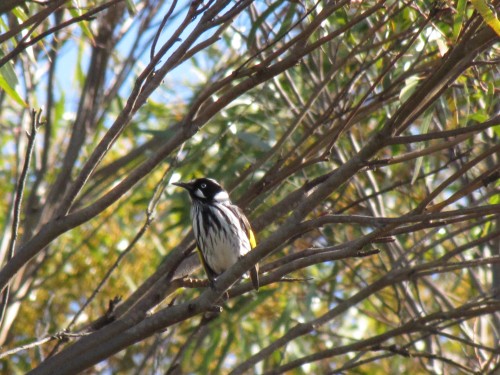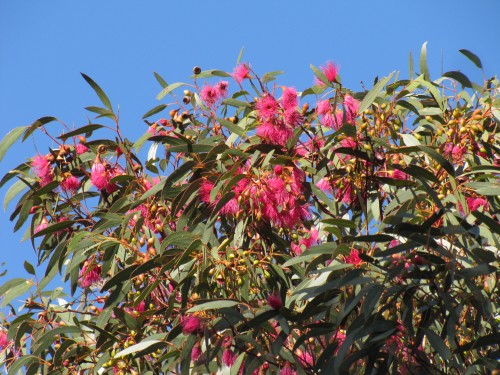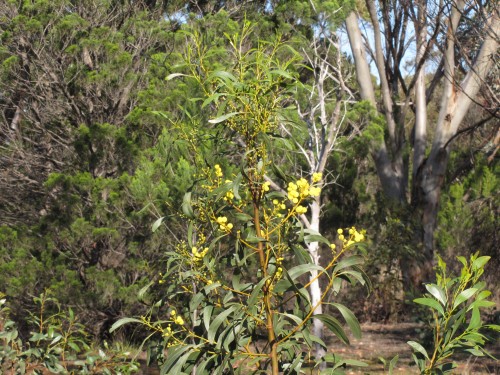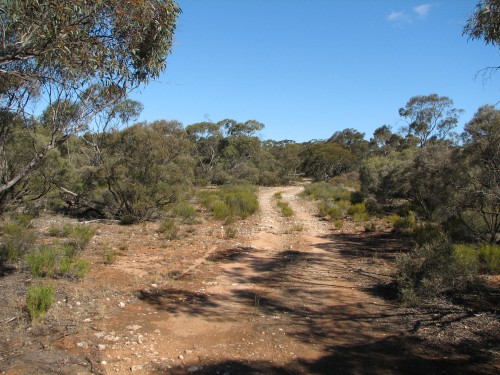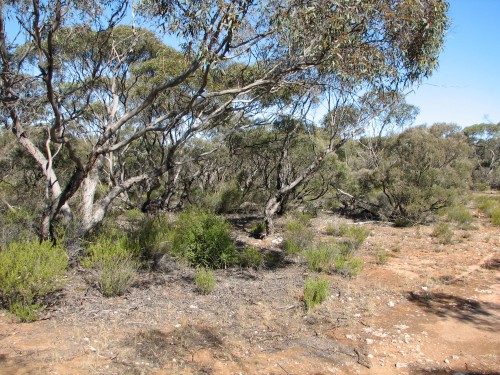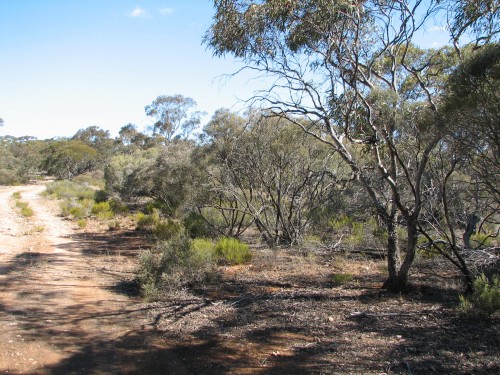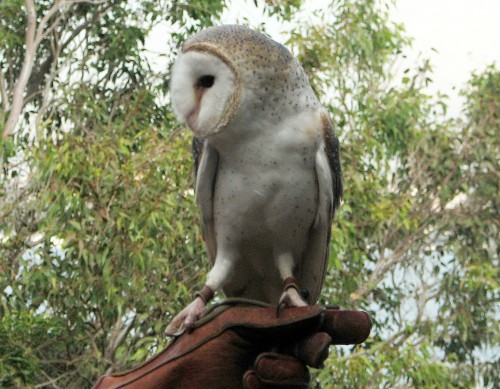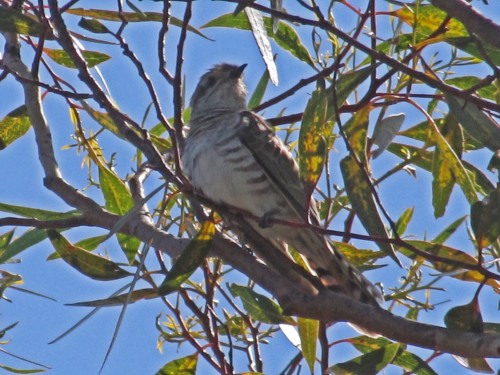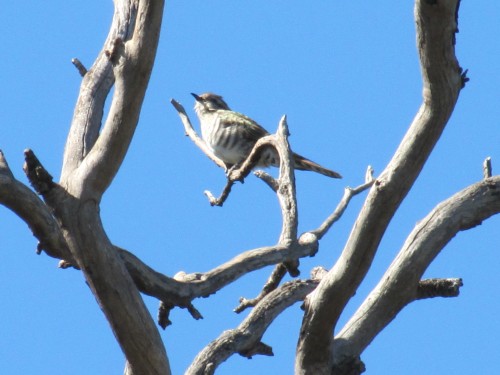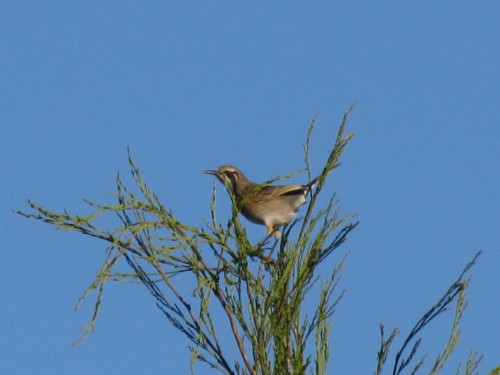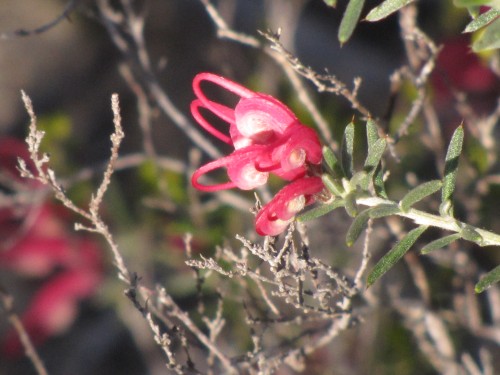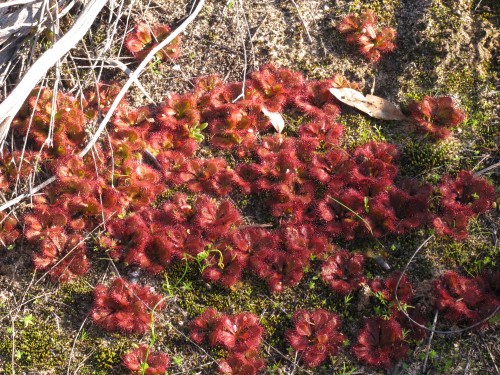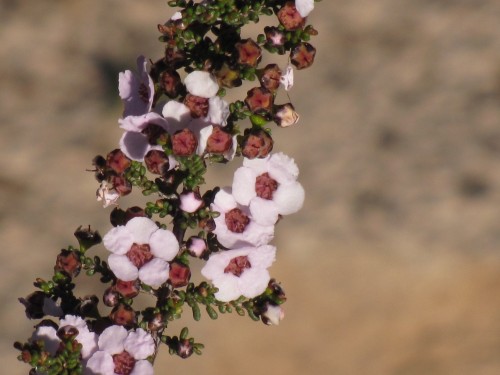Birding at Browns Road Monarto
This afternoon my wife and I took a detour coming home from Mt Barker in the Adelaide Hills. We had been there for a appointment, after which we had a relaxing lunch in one of the local cafes. Instead of taking the South-Eastern Freeway home to Murray Bridge we took the old Princes Highway route. It is a longer, more circuitous route but far more interesting.
Just past Callington we turned off into Browns Road near Monarto. We stopped at a spot where we could park the car safely before going on a short walk through the scrub. The sign on the gate says “Monarto Woodlands” but local birders usually refer to this area as Browns Road.
The scrub here is a confusing mixture of plant species. While there are some species common to the surrounding region, many of the trees and shrubs are introduced from other parts of Australia. A quick glance shows many Western Australian species, for example. This has come about due to extensive planting back in the 1980s when this area was designated as a satellite city to Adelaide. While a large area of farming land was purchased by the then state government, and the city was planned, no building ever occurred and much of the land has been returned to productive agricultural use. The only exception has been the establishment nearby of Monarto Open Range Zoo, part of Adelaide Zoo (and well worth a visit too, I might add).
We didn’t have all that much time on our visit this afternoon and my back and hips were being quite a pain. In the few minutes we were there I managed to record the following species:
- White-winged Chough
- Singing Honeyeater
- Red wattlebird
- New Holland Honeyeater (pictured above)
- White-browed Babbler
- Peaceful Dove
- Crested Pigeon
- Grey Fantail
- Willie Wagtail
- Yellow Thornbill
- Spiny-cheeked Honeyeater
- Silvereye
- Grey Shrike-thrush
- Common Starling
- Adelaide Rosella
- Australian Magpie (white backed)
- Weebill
While this is not a great list it is not bad for about ten minutes of birding. In recent weeks many other South Australian birders have visited this area and have reported far more species. I must visit more often, seeing it is about a 20 minute drive from home.
Some of the plants flowering are shown in the photos below.
Further reading:
Birding in Lowan Conservation Park
A few Sundays ago we had a break in our cold, wintry weather and we went for a drive to Lowan Conservation Park, a 40 minute drive north east from home in Murray Bridge, South Australia. The park is about 15 kilometres south east of Bowhill. I had visited this park on several previous occasions and found that the birding can be either a feast or a famine; it all depends largely on what is in flower, or the weather conditions.
The park is predominantly mallee woodland (see photos) with a mixture of other smaller scrubs and bushes. My wife has written about some of the plants on her site here.
On our most recent visit I didn’t even bother to take any photos; I saw no birds to photograph, well, none within range. And while we had our picnic afternoon tea in the sun I heard very little. It was a real struggle to get a short list of birds – mostly heard. (PS The photos on this post were taken on another visit.)
Bird list:
- Little Raven
- Mallee Ringneck
- Grey Shrike-thrush
- Weebill
- White-winged Chough
- Singing Honeyeater
- Australian Magpie
- Grey Butcherbird
- Galah
- Grey Fantail
- Noisy Miner? (or Yellow-throated Miner? – I only heard them)
- Striated Pardalote
That is not a great list, but there was not much flowering. In a park of some 660 hectares one would expect far more honeyeaters, but the mallee has to be in flower. Honeyeater species I would expect to see – or already have seen on other occasions – include: Striped, White-fronted, White-eared, White-plumed, Spiny-cheeked, Purple-gaped, Yellow-plumed, Brown-headed, New Holland and Red Wattlebird.
In addition to the honeyeaters I would expect to see more parrots, pigeons, wrens, thornbills, chats, woodswallows, robins (I did see one, but it flew off before I could get a positive ID), owls, nightjars, frogmouths, swallows, cuckoos, eagles, kites, falcons and even a Malleefowl or two. I have seen two Chestnut Quail-thrush there many years ago; I hope that they are still around.
I guess that the best time to visit would be in the spring, when there is a chance of more flowers. I think that it might be worth camping there overnight. By the way – there is only a rough, stony and sometimes sandy track through the park and NO facilities at all.
Trevor
Further reading:
Cold weather birding
I didn’t do much birding today.
Or yesterday.
I decided that the weather was far too cold. We are having a really cold winter’s snap here in South Australia with heavy rain, very cold temperatures, blustery winds and even snow. Snow in our state is such a rarity it receives plenty of coverage in the news. We average one snow fall every few years and it only lasts a few moments on the ground – if it reaches the ground. Nothing like the countries where some of my readers reside, I know, but then you don’t have to contend with our severe summers which we take in our stride. Or our snakes. Or spiders. Or sharks… you get the picture?
Despite the cold, inclement weather I was still able to be aware of the birds in and around our home and garden. The New Holland Honeyeaters and Red Wattlebirds were busily feeding on a few native plants and trees which are currently flowering. The Australian Magpies have stopped fussing about whether it is time to start building nests yet. A small party of White-browed Babblers scratched their way through the leaf litter a few days ago and the little family of Superb Fairy-wrens always seem to be happy to flit and hop around the garden, no matter what the weather dishes up.
Yesterday I noticed two Little Ravens scratching around in the grass I haven’t mowed recently. They seemed to be having a good feast. A few days ago I also heard several Grey Currawongs calling but they must have been just passing through our mallee scrub and not stopping. Earlier in the week I heard a Barn Owl screeching outside during the evening; we had visitors at the time so I didn’t go out searching for it.
Further reading:
- Just click on the name of any of the species mentioned in this post. A link will take you to photos and stories about each of the species mentioned. Reading those articles might help you to while away some poor weather in your part of the world.
An early Horsfield’s Bronze-cuckoo
I meant to write this post about two weeks ago. I have been distracted by other things; it happens.
First thing one morning just on two weeks ago I was on my way out and I heard the distinctive call of a Horsfield’s Bronze-cuckoo. I was running late for a meeting so I didn’t have time to track it down and get a photo but I know its call from years of hearing it around our home and garden. The photos I have shared today were taken some time ago and are not brilliant, but they give you a general idea of the appearance of this species.
What was interesting about this record is the early nature of the visit in late June. Most of the cuckoos we see and hear on our property are later in the year, especially around spring time when many species are nesting. I have also been reading quite a few reports online by other birders of various cuckoos appearing in southern Australia in recent weeks. One field guide I consulted claims that this species migrates to southern Australia and breeds from June to March, so it is not really all that early after all.
Sometimes I wonder if our birds actually read the field guides and follow the instructions therein.
Tawny-crowned Honeyeater at Monarto CP
A few days ago my wife and I took advantage of a lovely sunny winter’s day. We’ve had some very gloomy overcast weather in the last month or so, and some sunshine was an event to celebrate. We went for a drive to Monarto Conservation Park which is about a 15 minute drive from our home in Murray Bridge. Monarto CP is about 60km south east of Adelaide in South Australia.
Mind you, the sun may have been shining, and there were no clouds in the sky, and we were well rugged up, but the breeze was still chilly. Never mind, we packed the folding chairs, a Thermos of hot water, some tea bags and some biscuits for afternoon tea. We were prepared.
Before indulging in our treats we went on the walking trail through the park. This is an easy, almost level sandy track through several different habitats. Despite the recent poor weather we were delighted to see so many native plants in flower. I have included a few photos below. While my wife has a good working knowledge of our native birds, her main interest is in the native plants (you can read about her interest on her site here).
I have found over the years that birding in the Monarto Conservation Park can be rather hit or miss. Sometimes the birds can be singing and busily feeding and flying around. On other occasions the bird life can be quiet and inactive. Much of this is due to two main factors: weather conditions and what is flowering.
On this occasion there seemed to be a great deal of activity but, wouldn’t you know it – the birds were not showing themselves all that much. In fact, I only managed reasonable – certainly not brilliant – photos of one species: the Tawny-crowned Honeyeater as shown in the photo above. I should be pleased; the photos taken were the first I have managed of this species.
This honeyeater is a widespread species of southern Australia, from coastal NSW and Tasmania, much of Victoria, southern South Australia and south-western Western Australia. Its preferred habitats include mallee, heathlands, eucalyptus woodlands and street trees. It can easily be confused with the similar looking Crescent Honeyeater – which initially I did.
Further reading:
- Crescent Honeyeater
- An afternoon walk in Monarto Conservation Park
- Birds of Monarto Conservation Park
Bird list:
- Spiny-cheeked Honeyeater
- Red Wattlebird
- Mallee Ringneck parrot
- Silvereye
- Grey Shrike-thrush
- Australian Magpie
- Southern Scrub-robin
- Grey Currawong
- Weebill
- Grey Fantail
- New Holland Honeyeater
- Brown-headed Honeyeater
- Grey Butcherbird
- Tawny-crowned Honeyeater
- Little Raven
- Willie Watail
- Black-faced Cuckoo-shrike
- Shy heathwren
